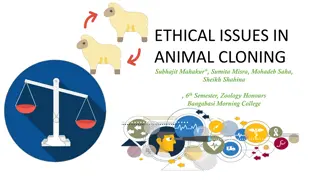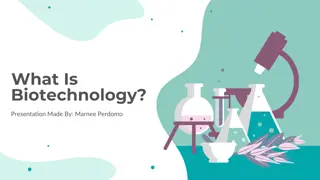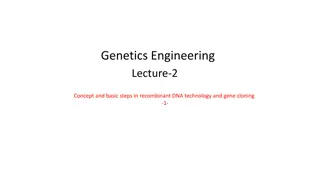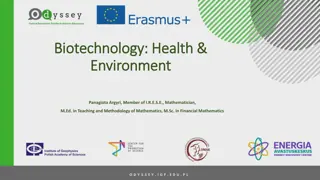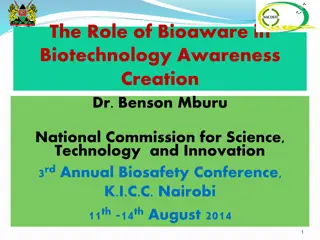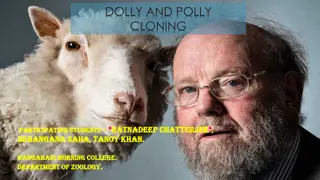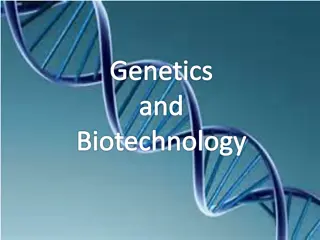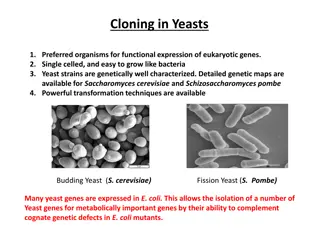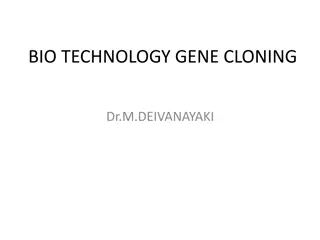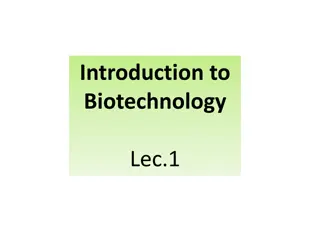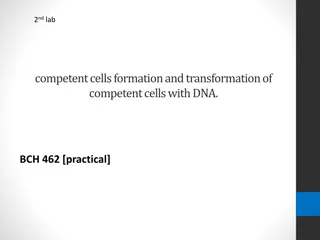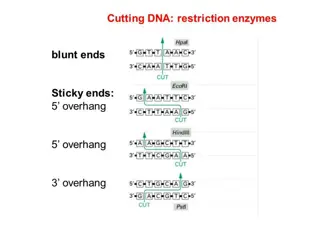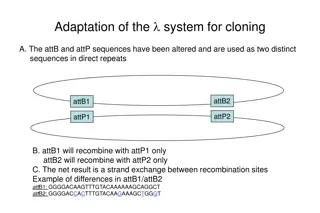
Cloning in Biology and Biotechnology
Cloning in biology refers to producing genetically identical individuals, while in biotechnology it involves copying DNA fragments, cells, or organisms. Molecular cloning amplifies DNA sequences for various applications, from genetic experiments to protein production. The process includes steps like DNA fragmentation, ligation, transfection, and selection, using specialized vectors and replication origins. Understanding the principles and steps of DNA cloning is essential for research and biotechnological advancements.
Download Presentation

Please find below an Image/Link to download the presentation.
The content on the website is provided AS IS for your information and personal use only. It may not be sold, licensed, or shared on other websites without obtaining consent from the author. If you encounter any issues during the download, it is possible that the publisher has removed the file from their server.
You are allowed to download the files provided on this website for personal or commercial use, subject to the condition that they are used lawfully. All files are the property of their respective owners.
The content on the website is provided AS IS for your information and personal use only. It may not be sold, licensed, or shared on other websites without obtaining consent from the author.
E N D
Presentation Transcript
Cloning In biology, Cloning is the process of producing similar populations of genetically identical individuals that occurs in nature when organisms such as bacteria, Insects or Plants reproduce asexually. Cloning in Biotechnology refers to processes used to create copies of DNA fragments (Molecular Cloning), Cells (cell cloning), or Organism. The term also refers to the production of multiple copies of a product such as Digital Mediator Software.
Molecular cloning Molecular cloning refers to the process of making multiple molecules. Cloning is commonly used to amplify DNA fragments containing whole genes, but it can also be used to amplify any DNA sequence such as promotors, non-coding sequences and randomly fragmented DNA. It is used in a wide array of biological experiments and practical applications ranging from genetic fingerprinting to large scale protein production. Occasionally, the term cloning is misleadingly used to refer to the identification of the chromosomal location of a gene associated with a particular phenotype of interest, such as in positional cloning. In practice, localization of the gene to a chromosome or genomic region does not necessarily enable one to isolate or amplify the relevant genomic sequence.
To amplify any DNA sequence in a living organism, that sequence must be linked to an origin of replication, which is a sequence of DNA capable of directing the propagation of itself and any linked sequence. However, a number of other features are needed and a variety of specialized Cloning Vectors (small piece of DNA into which a foreign DNA fragment can be inserted) exist that allow protein expression, tagging, single stranded RNA and DNA production and a host of other manipulations.
Steps of DNA Cloning Fragmentation - breaking apart a strand of DNA Ligation - gluing together pieces of DNA in a desired sequence Transfection - inserting the newly formed pieces of DNA into cells Screening / Selections - selecting out the cells that were successfully transfected with the new DNA
Initially, the DNA of interest needs to be isolated to provide a DNA segment of suitable size. Subsequently, a ligation procedure is used where the amplified fragment is inserted into a Vector (piece of DNA). The vector (which is frequently circular) is linearized using restriction enzymes, and incubated with the fragment of interest under appropriate conditions with an enzyme called DNA ligase. Following ligation the vector with the insert of interest is transfected into cells. A number of alternative techniques are available, such as chemical sensitivation of cells, electroporation, optical injection and biolistics. Finally, the transfected cells are cultured.
As the aforementioned procedures are of particularly low efficiency, there is a need to identify the cells that have been successfully transfected with the vector construct containing the desired insertion sequence in the required orientation. Modern cloning vectors include selectable antibiotic resistance markers, which allow only cells in which the vector has been transfected, to grow. Additionally, the cloning vectors may contain color selection markers, which provide blue/white screening (alpha-factor complementation) on X-gal medium. Nevertheless, these selection steps do not absolutely guarantee that the DNA insert is present in the cells obtained. Further investigation of the resulting colonies must be required to confirm that cloning was successful. This may be accomplished by means of PCR, restriction fragment analysis and/or DNA sequencing.
Basics of DNA Cloning Cloning is making of identical copies. DNA cloning is process of making several identical copy of a gene or gene fragment. DNA fragment from an organism is cleaved or amplified and inserted in a DNA carrier called vector.
Cloning is a natural process in biology where genetically identical individuals are produced by asexually reproducing organisms such as bacteria, insects or plants. In biotechnology, the process of producing multiple identical copies of DNA fragments (molecular cloning), cells (cell cloning), or organisms is referred to as cloning. A clone has an exact genetic imprint as that of the original cell, tissue or organism. There are different types of cloning 1-Reproductive cloning 2-Therapeutic cloning 3-Embryo cloning In Biotechnology the gene is the cornerstone of most molecular biology studies. The study of genes can be facilitated by isolation and amplification of gene of interest. Cloning is one method used for isolation and amplification of gene of interest.
Cloning Steps The first step in cloning is to prepare large amount of the vector and chromosomal DNAs All vectors are self replicating in the cell, they contain a number of unique restriction enzyme cleaving sites that are present only once in the vector, they carry the selectable marker gene which is useful in selection of clone (usually an antibiotic resistance gene that is absent in the host cell) and, they can be very easily isolated from host cell. Depending on the purpose of cloning there are many vectors available. For use in the bacterial host E. coli system a greatest variety of cloning vectors have been developed. Thus, the first thing in cloning that a molecular biologist requires is to grow pure culture and isolate the cloning vector from the cells.
Choice of vector is dependent on insert size and application The different types of vectors available for cloning are Plasmids, bacteriophages, bacterial artificial chromosomes (BACs), Yeast artificial chromosomes (YACs) and Mammalian artificial chromosomes (MACs). Plasmids: Plasmids are extra chromosomal circular double stranded DNA replicating elements present in bacterial cells. Plasmids show the size ranging from 5.0 kb to 400 kb.
Plasmids are inserted into bacterial calls by a process called transformation. Plasmids can accommodate an insert size of upto 10 kb DNA fragment. Generally plasmid vectors carry a marker gene which is mostly a gene for antibiotic resistance; thereby making any cell that contains the plasmid will grow in presence of the selectable corresponding antibiotic supplied in the media.


